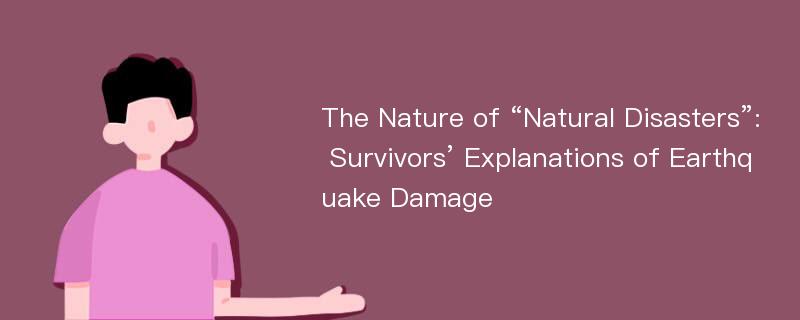
论文摘要
The distinction between natural and human-made disasters is ingrained in everyday language. Disaster scientists have long been critical of this dichotomy. Nonetheless,virtually no attention has been paid to how disaster survivors conceptualize the causes of the disasters they experience. In this mixed-methods longitudinal study, 112 survivors of the2016–2017 Central Italy earthquakes completed questionnaires 3 and 16 months following the earthquakes, with the aim of assessing attributions of blame for the earthquake damage. In-depth interviews were also conducted with 52 participants at the 3-month mark to explore representations of causation for the earthquake damage. The distinction between disasters caused by nature and disasters caused by humans was not supported by survivors of the earthquake. In the longitudinal surveys, building firms and the State were assigned as much blame as nature for the earthquake damage, at both 3 months and 16 months after the earthquakes.Corroborating this complexity, in the interviews, the causes of the earthquake damage, rather than being understood as purely natural, were perceived as a complex mosaic composed of political, technological, natural, and moral factors.This empirical work shows that disaster survivors combine both nature-based and human-based explanations of disasters, rather than subscribing to one or the other. These findings have practical implications for disaster risk reduction and response.
论文目录
文章来源
类型: 期刊论文
作者: Alessandro Massazza,Chris R.Brewin,Helene Joffe
来源: International Journal of Disaster Risk Science 2019年03期
年度: 2019
分类: 工程科技Ⅰ辑,基础科学
专业: 地质学,地球物理学,安全科学与灾害防治
单位: Department of Clinical, Educational and Health Psychology,University College London
基金: the municipality and health center of Amatrice,the psychiatric services of Rieti for their practical support,the UK’s Economic and Social Research Council for their financial support
分类号: X43;P315.9
页码: 293-305
总页数: 13
文件大小: 264K
下载量: 7
相关论文文献
- [1].Integrated Disaster Prevention and Reduction for Areas along the Belt and Road during the 14th Five-Year Plan Period: Global Disaster Reduction and Key Issues for Major Areas[J]. Asian Agricultural Research 2019(11)
- [2].Challenges with Disaster Mortality Data and Measuring Progress Towards the Implementation of the Sendai Framework[J]. International Journal of Disaster Risk Science 2019(04)
- [3].Disaster Knowledge Gaps: Exploring the Interface Between Science and Policy for Disaster Risk Reduction in Europe[J]. International Journal of Disaster Risk Science 2020(01)
- [4].Disaster is heartless, but everyone has love[J]. 中国研究型医院 2020(01)
- [5].The Sendai Framework for Disaster Risk Reduction at Five:Lessons from the 2011 Great East Japan Earthquake and Tsunami[J]. International Journal of Disaster Risk Science 2020(02)
- [6].Remembering,Forgetting,and Absencing Disasters in the Post-disaster Recovery Process[J]. International Journal of Disaster Risk Science 2020(03)
- [7].Sendai Five Years on: Reflections on the Role of International Law in the Creation and Reduction of Disaster Risk[J]. International Journal of Disaster Risk Science 2020(02)
- [8].Disaster Risk Science: A Geographical Perspective and a Research Framework[J]. International Journal of Disaster Risk Science 2020(04)
- [9].Fuzzy Boundaries Between Post-Disaster Phases: The Case of L'Aquila, Italy[J]. International Journal of Disaster Risk Science 2016(03)
- [10].Research progress in disaster nursing competency framework of nurses in China[J]. Chinese Nursing Research 2016(04)
- [11].Healthcare Services Demand in Post-disaster Settings:The 2014 Earthquake in Ludian County,Yunnan Province,China[J]. International Journal of Disaster Risk Science 2016(04)
- [12].Health and Risks:Integrating Health into Disaster Risk Reduction,Risk Communication,and Building Resilient Communities[J]. International Journal of Disaster Risk Science 2017(02)
- [13].A Systematic Study of Disaster Risk in Brunei Darussalam and Options for Vulnerability-Based Disaster Risk Reduction[J]. International Journal of Disaster Risk Science 2017(02)
- [14].Protecting People from Natural Disasters[J]. China Today 2017(06)
- [15].An Emergent Framework of Disaster Risk Governance towards Innovating Coping Capability for Reducing Disaster Risks in Local Communities[J]. International Journal of Disaster Risk Science 2011(02)
- [16].International Journal of Disaster Risk Science Instructions for Authors[J]. International Journal of Disaster Risk Science 2011(02)
- [17].Disaster Preparedness:Looking through the Lens of Hospitals in Japan[J]. International Journal of Disaster Risk Science 2013(02)
- [18].Implementation of Disaster Reduction Measures and Enhancement of Integrated Risk Governance in China[J]. International Journal of Disaster Risk Science 2013(02)
- [19].International Journal of Disaster Risk Science Instructions for Authors[J]. International Journal of Disaster Risk Science 2013(02)
- [20].Urban Resilience in Post-Disaster Reconstruction: Towards a Resilient Development in Sichuan,China[J]. International Journal of Disaster Risk Science 2012(01)
- [21].Towards a Policy that Supports People-Centered Housing Recovery——Learning from Housing Reconstruction after the Hanshin-Awaji Earthquake in Kobe,Japan[J]. International Journal of Disaster Risk Science 2012(01)
- [22].International Journal of Disaster Risk Science Instructions for Authors[J]. International Journal of Disaster Risk Science 2012(01)
- [23].Community Disaster Management Assets:A Case Study of the Farm Community in Sussex County,Delaware[J]. International Journal of Disaster Risk Science 2013(01)
- [24].International Journal of Disaster Risk Science Instructions for Authors[J]. International Journal of Disaster Risk Science 2013(01)
- [25].Lessons from International Students' Reaction to the 2011 Great East Japan Earthquake:The Case of the School of Engineering at Tohoku University[J]. International Journal of Disaster Risk Science 2013(03)
- [26].International Journal of Disaster Risk Science Instructions for Authors[J]. International Journal of Disaster Risk Science 2013(03)
- [27].International Journal of Disaster Risk Science Instructions for Authors[J]. International Journal of Disaster Risk Science 2014(04)
- [28].International Journal of Disaster Risk Science[J]. International Journal of Disaster Risk Science 2014(01)
- [29].Near-Real-Time Analysis of Publicly Communicated Disaster Response Information[J]. International Journal of Disaster Risk Science 2014(03)
- [30].Haiti 2010 Earthquake——How to Explain Such Huge Losses?[J]. International Journal of Disaster Risk Science 2011(01)
